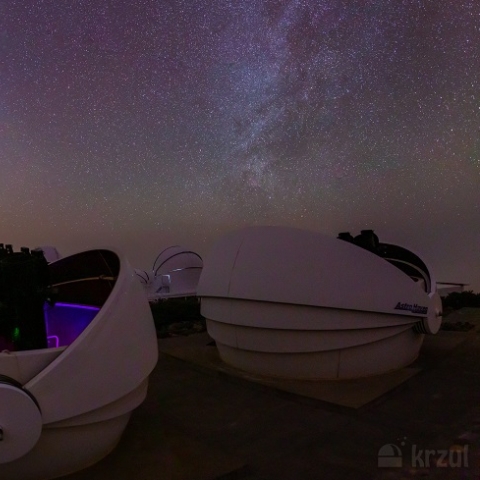

The catalogue is the result of The Physics of the Accelerating Universe Survey (PAUS)
18 September 2024
A new catalogue providing information on millions of distant galaxies, which determines their distances with unprecedented precision over a field of view and depth never before explored, has been published today.
The catalogue is the result of The Physics of the Accelerating Universe Survey (PAUS), an international collaboration led by the Institute of Space Sciences (ICE-CSIC), dependent on the Ministry of Science, Innovation and Universities (MICIU), which involves 14 institutions across six countries - including the University of Portsmouth.
Collected over 200 nights between 2015 and 2019 using the PAUCam camera on the William Herschel Telescope in La Palma, this catalogue is now available on the PAUS website and the CosmoHub web portal.
Covering a vast sky area of 50 square degrees, similar to an area of approximately 250 full moons, the catalogue includes data for 1.8 million astronomical objects. These insights will enable astronomers to create more accurate maps to understand how structure forms in the Universe and to study dark matter and dark energy.

The William Herschel Telescope in La Palma, Spain. Image credit: PAUS team.
Enrique Gaztañaga, Director of the PAUS Survey and Professor at the University of Portsmouth’s Institute of Cosmology and Gravitation, said: "The PAU Survey offers a groundbreaking approach to creating cosmic maps, made possible through the design and development of a novel instrument and a dedicated survey to collect and analyse data in ways never done before. It has been a privilege to collaborate with such a talented and dependable group.”
The accelerated expansion of the Universe is attributed to dark energy, which constitutes about 70 per cent of the Universe, yet its nature remains a mystery. The PAUS survey offers new insights into this enigma, providing an accurate and comprehensive characterisation of millions of galaxies up to distances of more than 10 billion light years.
This catalogue is a valuable resource for the astronomical community, aiding in the scientific analysis and calibration of other cosmological surveys.
The PAUCam camera was specially designed to accurately measure galaxy distances, enabling the study of the Universe's expansion under the influence of dark matter and dark energy.
The PAU Survey offers a groundbreaking approach to creating cosmic maps, made possible through the design and development of a novel instrument and a dedicated survey to collect and analyse data in ways never done before.
Enrique Gaztañaga, Director of the PAUS Survey and Professor at the University of Portsmouth’s Institute of Cosmology and Gravitation
The project builds on existing deep images from the Canada-France-Hawaii Telescope Lensing Survey (CFHTLenS), carried out with the Canada-France-Hawaii Telescope in Hawaii, and the Kilo-Degree Survey (KiDS) carried out with the European Southern Observatory’s VLT Survey Telescope in Chile. By combining these datasets, PAUS has achieved highly accurate distance and time information for deep space objects.
This catalogue represents a significant advancement in cosmic research with its extensive catalogue offering photometric redshift measurements that determine the distances of galaxies as they appeared billions of years ago.
To achieve these measurements, the PAU camera employs 40 filters across different colours, representing narrow bands in the optical spectrum. This technique involves photographing the same field multiple times through various colour filters. As objects move away from us, the light they emit experiences a redshift, shifting towards the red end of the spectrum. In astronomy, redshift is crucial for calculating the distance of an object from Earth.
David Navarro-Gironés, PhD student at ICE-CSIC and first author of the paper published today, said: "The precision in measuring galaxy distances depends on the number of filters you use, as each filter provides different information about the galaxy.
“The great advantage of PAUS is that it combines information from 40 different filters, allowing for highly accurate distance measurements. This level of precision is crucial for the study of the structure of the universe, which in turn requires data from a large number of galaxies.”
The release is detailed in two articles published today in the Monthly Notices of the Royal Astronomical Society (MNRAS): one measuring distances and another one on calibration of the PAUS data.
In the coming months, the team will also present an ongoing study on galaxy clustering and intrinsic galaxy shape alignments, contributing to a deeper understanding of how our universe formed and evolved.
You might also like...
Lift off for new course as part of £2.1m funding to address skills gap in UK space sector
27 August 2024
3 minutes

Citizen science project identifies 20 new astronomical discoveries
23 August 2024
8

Portsmouth Professor awarded Freedom of the City of London
A University of Portsmouth Professor is one of the leading figures from the worlds of science, medicine, business, academia, education, and arts, who has been awarded the Freedom of the City of London.
5 August 2024
4 min read

